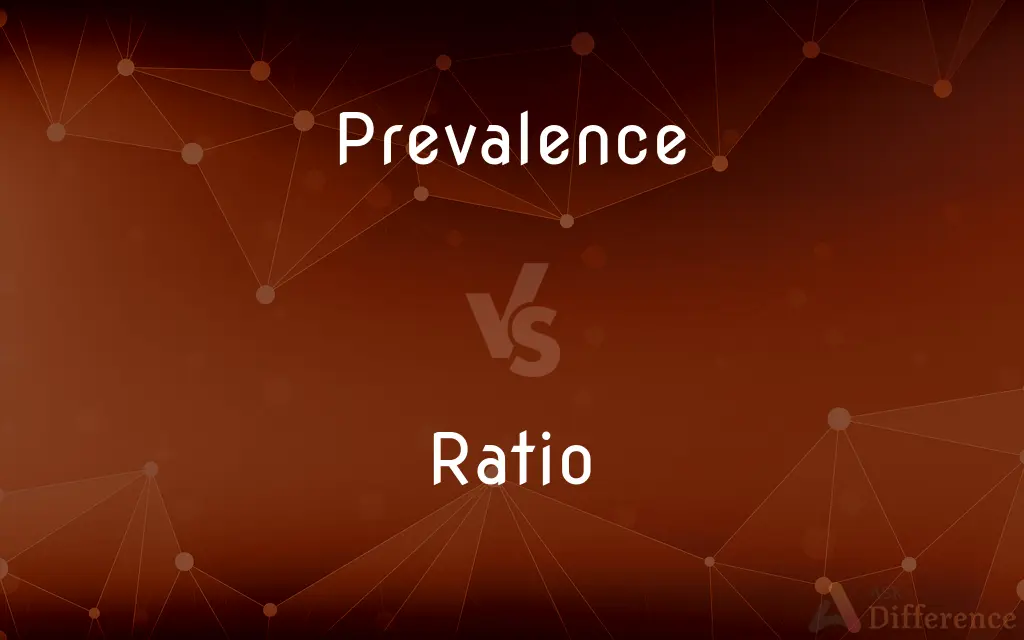Prevalence vs. Ratio — What's the Difference?
By Maham Liaqat & Urooj Arif — Updated on April 8, 2024
Prevalence quantifies the proportion of individuals in a population with a certain condition at a specific time, while a ratio compares two quantities, showing their relative sizes.

Difference Between Prevalence and Ratio
Table of Contents
ADVERTISEMENT
Key Differences
Prevalence is a measure used in epidemiology to describe the proportion of individuals in a population who have a particular disease or attribute at a given time. It helps public health officials understand the burden of a health condition on a population. In contrast, a ratio is a way to compare two quantities to see how much larger one is than the other, and it's used in various fields, not just health.
Prevalence is calculated by dividing the number of cases of a disease present in the population at a specified time by the number of individuals in the population at that time, often expressed as a percentage or per 1,000 or 100,000 people. Ratios, on the other hand, can be expressed in various ways, such as a simple numerical ratio (1:2), a fraction (½), or a decimal (0.5), depending on the context and what is being compared.
The concept of prevalence is specific to epidemiology and public health, highlighting the extent of a health issue within a community at a particular time. This differs from a ratio, which is a broader mathematical concept applied in countless scenarios, from comparing the number of apples to oranges in a basket to analyzing financial statements.
Prevalence provides insights into the level of disease burden and the need for healthcare resources in a particular population. It informs decision-makers about the allocation of resources and the planning of health services. Ratios, while versatile, serve the purpose of showing the relative size or performance of different entities, making them indispensable in decision-making across various domains, including finance, education, and engineering.
The use of prevalence is crucial in tracking the progress of disease interventions, determining if the number of cases in a population is increasing or decreasing over time. Ratios are utilized to compare different datasets, evaluate efficiency, or measure performance changes over time, demonstrating their utility in both static comparisons and dynamic analyses.
ADVERTISEMENT
Comparison Chart
Definition
The proportion of a population with a certain condition at a specific time.
A comparison of two quantities showing their relative sizes.
Field of Use
Epidemiology, public health.
Mathematics, finance, science, everyday life.
Expression
Percentage, per 1,000 or 100,000 people.
Numerical ratio, fraction, decimal.
Key Purpose
Measure the burden of disease in a population.
Show relative size or performance of entities.
Application Example
Determining the prevalence of diabetes in a community.
Comparing the number of males to females in a study.
Compare with Definitions
Prevalence
Public Health Indicator.
A high prevalence of smoking reflects widespread tobacco use, necessitating targeted health interventions.
Ratio
Statistical Analysis Component.
Ratios are used in statistics to compare the occurrence of outcomes in different groups.
Prevalence
Epidemiological Tool.
Prevalence rates help in the planning and allocation of healthcare resources.
Ratio
Mathematical Relationship.
The ratio of width to height in a video format, like 16.9, defines its aspect ratio.
Prevalence
Population Health Measurement.
Tracking the prevalence of heart disease helps understand trends and the effectiveness of prevention strategies.
Ratio
Financial Analysis Tool.
The debt-to-equity ratio is crucial for assessing a company's financial health.
Prevalence
Measure of Disease Burden.
The prevalence of obesity in a community indicates the percentage of the population that is obese.
Ratio
Efficiency Indicator.
The ratio of output to input in a production process measures its efficiency.
Prevalence
Snapshot in Time.
The prevalence of HIV provides a snapshot of the disease's impact on a population at a specific moment.
Ratio
Comparative Measure.
The ratio of nurses to patients in a hospital shows the staffing levels relative to patient needs.
Prevalence
In epidemiology, prevalence is the proportion of a particular population found to be affected by a medical condition (typically a disease or a risk factor such as smoking or seatbelt use) at a specific time. It is derived by comparing the number of people found to have the condition with the total number of people studied and is usually expressed as a fraction, a percentage, or the number of cases per 10,000 or 100,000 people.
Ratio
In mathematics, a ratio indicates how many times one number contains another. For example, if there are eight oranges and six lemons in a bowl of fruit, then the ratio of oranges to lemons is eight to six (that is, 8∶6, which is equivalent to the ratio 4∶3).
Prevalence
The condition of being prevalent.
Ratio
The quantitative relation between two amounts showing the number of times one value contains or is contained within the other
The ratio of men's jobs to women's is 8 to 1
Prevalence
(Medicine) The total number of cases of a disease in a given population at a specific time.
Ratio
Relation in degree or number between two similar things.
Prevalence
The quality or condition of being prevalent; wide extension or spread.
Ratio
The relative value of silver and gold in a currency system that is bimetallic.
Prevalence
(epidemiology) The total number of cases of a disease in a given statistical population at a given time, divided by the number of individuals in that population.
Ratio
(Mathematics) A relationship between two quantities, normally expressed as the quotient of one divided by the other; for example, the ratio of 7 to 4 can be written 7:4 or 7/4. A ratio can often also be expressed as a decimal or percentage.
Prevalence
The quality or condition of being prevalent; superior strength, force, or influence; general existence, reception, or practice; wide extension; as, the prevalence of virtue, of a fashion, or of a disease; the prevalence of a rumor.
The duke better knew what kind of argument were of prevalence with him.
Ratio
A number representing a comparison between two named things.
Prevalence
The quality of prevailing generally; being widespread;
He was surprised by the prevalence of optimism about the future
Ratio
(arithmetic) The relative magnitudes of two quantities (usually expressed as a quotient).
Prevalence
(epidemiology) the ratio (for a given time period) of the number of occurrences of a disease or event to the number of units at risk in the population
Ratio
(legal) ratio decidendi
Prevalence
A superiority in numbers or amount;
There is a preponderance of Blacks in our prisons
Ratio
(Internet) The number of comments to a post or other expression on social media relative to the number of likes; a high ratio suggests disagreement with the contents of the original post.
Ratio
To respond to a post or message on social media in a greater number than the number of likes the post receives, especially to condemn or mock the original poster.
The politician's post was quickly ratioed due to its controversial nature.
Ratio
Indicates disagreement with a post the user disagrees with or dislikes.
L + ratio
Ratio
The relation which one quantity or magnitude has to another of the same kind. It is expressed by the quotient of the division of the first by the second; thus, the ratio of 3 to 6 is expressed by
Ratio
Hence, fixed relation of number, quantity, or degree; rate; proportion; as, the ratio of representation in Congress.
Ratio
The relative magnitudes of two quantities (usually expressed as a quotient)
Common Curiosities
How is prevalence different from incidence?
Prevalence measures how widespread a condition is at a specific time, while incidence measures the rate of new cases over a period.
How can ratios impact decision-making?
Ratios provide insights into relationships between different factors, aiding in financial decisions, resource allocation, and performance evaluation.
What is prevalence?
Prevalence is a statistic that shows the proportion of a population affected by a specific condition at a given time.
Is the calculation of prevalence complex?
The calculation of prevalence can be straightforward, involving the division of the number of existing cases by the total population, but interpreting its implications requires understanding of the context.
What is a ratio?
A ratio is a mathematical expression that compares two quantities, showing how much larger one is than the other.
Can prevalence be expressed as a ratio?
Yes, prevalence can be expressed as a ratio, comparing the number of affected individuals to the total population.
What factors can influence the ratio of a company's financial metrics?
Factors include changes in debt levels, equity changes, operational efficiency improvements, and market conditions.
Where are ratios used?
Ratios are used in various fields, including mathematics, finance, science, and everyday life, to make comparisons between quantities.
Why is understanding prevalence important?
Understanding prevalence is important for assessing the burden of disease, planning healthcare services, and allocating resources effectively.
Can prevalence rates change over time?
Yes, prevalence rates can change over time due to factors like new treatments, changes in population health behaviors, and disease eradication efforts.
How is prevalence used in epidemiological research?
Prevalence is used in epidemiological research to estimate the total burden of disease in a population, study disease patterns, and identify high-risk groups.
How do ratios and percentages differ?
Ratios compare two quantities directly, while percentages compare a part to a whole, expressing it as a fraction of 100.
How does prevalence affect public health policy?
Prevalence affects public health policy by highlighting priority health issues that need intervention and guiding the allocation of resources.
Why is the ratio important in statistical analysis?
Ratios are important in statistical analysis for comparing data sets, understanding relationships, and conducting hypothesis testing.
What is the significance of a high ratio in financial analysis?
A high ratio, such as a high debt-to-equity ratio, can indicate greater financial risk but also potentially higher returns.
Share Your Discovery

Previous Comparison
Phial vs. Vial
Next Comparison
Immaculate vs. PristineAuthor Spotlight
Written by
Maham LiaqatCo-written by
Urooj ArifUrooj is a skilled content writer at Ask Difference, known for her exceptional ability to simplify complex topics into engaging and informative content. With a passion for research and a flair for clear, concise writing, she consistently delivers articles that resonate with our diverse audience.















































